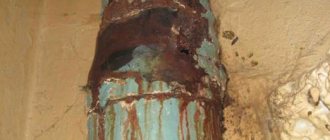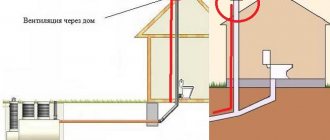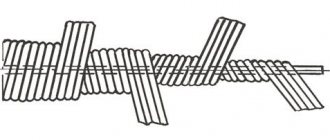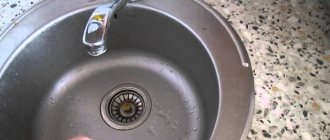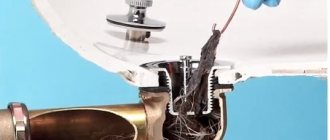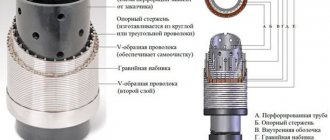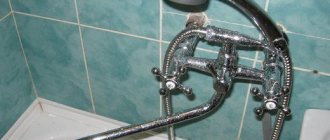The penetration of odors from sewer pipes and drains can not only complicate life in the house, but also negatively affect the health of residents.
There are several causes of sewer smell in the bathroom.
There are two main questions when there is a sewer smell in the bathroom: what are the causes and how to eliminate it. The solution to the problem may be cleaning the pipeline, adjusting ventilation, sealing joints, or re-installing the drainage system.
What harm can it cause to health?
Usually people believe that the smell from the bathroom in the house brings nothing but discomfort.
But this is not so, because household members inhale vapors of ammonia and hydrogen sulfide. There are methane impurities in the air. Inhaling toxic fumes every day, residents suffer from nervousness, they experience anxiety, restlessness, and irritability for no reason. Mold develops on the walls due to dampness.
Fungi enter the human body, causing the person to get sick. He develops pathologies of the respiratory organs and gastrointestinal tract. Staying in the room for a long time will lead to serious poisoning. Prolonged exposure to methane has a negative effect on the autonomic system of residents, which produces a nervous tic in the eye area. And oxygen starvation of brain cells causes weakness, nausea, dizziness, and a drop in blood pressure.
Sewer stench is dangerous
The sewer smell is impossible to get used to. Volatile gases coming from the siphon and pipes spread throughout all areas of the house or apartment. This stench is disgusting and spoils the mood. When guests arrive, the owners of the “fragrant” home have to apologize and make excuses.
Psychological discomfort is far from the worst thing that sewer stench brings with it. What is much worse is that it is dangerous to health. The ability to separate odors into pleasant and unpleasant is a biological mechanism that has ensured the survival of humanity for thousands of years. If the aroma seems unpleasant, it means it is potentially dangerous.
The air from the sewer system is “flavored” with ammonia and hydrogen sulfide. It also contains methane, which has no distinct odor. Volatile gases affect the state of the human nervous system. There may be a feeling of causeless anxiety, nervousness, and irritability.
The harm that sewer stench can cause to humans depends on the composition of the air and the concentration of toxic gases. In any case, the smell should be eliminated immediately as soon as it appears.
In a house that smells like sewer, people can become mopey, have breakdowns, have trouble sleeping, and even faint. Long-term exposure to hydrogen sulfide can lead to respiratory diseases: rhinitis, bronchitis.
With a high concentration of gas in the air, poisoning is possible, the symptoms of which are nausea, vomiting, headache, decreased blood pressure and dizziness.
Ammonia negatively affects vision, the respiratory system, causes a state of excitement, and has a general toxic effect. And methane can cause oxygen starvation of cells. Some disturbances in the functioning of the autonomic nervous system cannot be ruled out. For example, a “twitching eye” may well indicate long-term exposure to methane on the body.
At the first sign of a sewer smell in the bathroom or toilet, you should immediately begin to find the cause of the stench and eliminate it. Otherwise, the concentration of gases in the air will only increase, and this can lead to negative consequences for the health of the residents of the house.
Image gallery
Photo from
Interior of a combined bathroom
Connection to outlet via siphon
Regular and timely maintenance of plumbing fixtures
Effective ventilation to remove dirty air
Construction of the drainage system
The components of the sewer system include:
- pipes of various diameters necessary to drain water from the bathroom;
- ventilation and sewage risers;
- pressure manifold;
- water drainage lines.
Not only the bathroom, but also the shower room is connected to the system in a private house. The lowest point of the system is the wastewater outlet. A ventilation valve is installed on the top. This point is located above all water intake nodes. The functions of the valve include sealing the system so as not to allow harmful gases and odors to enter the room.
All outlets of the system into the collector are connected to the lower point ending with the siphon. This includes a bathroom and shower. All pipes must slope towards the collector well. An ideal sewer system does not have sharp turns of 90 degrees, and there are no changes in height within one branch.
Solution methods depending on the problem
Before you start studying the question of how to remove sewer smell from a bathroom or toilet, you need to correctly determine the cause of its occurrence. A correctly detected flaw will indicate what to do about the problem.
To check the operation of the ventilation system, use a regular sheet of paper. It must be attached to the grille covering the ventilation hole. If the leaf holds, the traction is excellent, the problem with the smell is not due to ventilation. If a leaf falls, you need to look for the cause of poor traction; perhaps the channels are clogged. Another popular way to test traction is to hold a lit match. With good ventilation, the flame will deflect towards the shaft.
If the problem is not ventilation, proceed to check the drainage in the sinks and bathtub. Open the taps to full pressure and monitor the flow of water into the drain hole. If the water drains slowly, there is a blockage. If the water drains well, but the smell remains, just pour boiling water down the drain, which will clean out the fatty deposits.
If, after checking the ventilation and pipes, there is no answer as to why there is a sewer smell in a private house, check the joints of the pipes and the base of the toilet for leaks. Place a clean white napkin under suspicious joints and observe. If it gets wet, the joint is not sealed.
If after all the checks the smell remains, it means that the problem is not inside the apartment, but in the common building riser. In this case, you cannot cope on your own; you need to call plumbers.
Troubleshooting ventilation problems
How to get rid of ventilation problems? The first step is to find the cause of the loss of traction. Often, the efficiency of the hood decreases when:
- the channels become clogged;
- the bathroom doors are pressed too tightly against the frame;
- neighbors on the lower floor installed a powerful fan in the shaft.
When assessing, it should be taken into account that on hot days the draft in the ventilation shaft is worse due to the external warm air, which does not allow the internal warm air to escape. To eliminate the difference, you just need to leave the bathroom door ajar.
To determine the problem, you need to remove the grille covering the ventilation hole, and then use a flashlight to look at the condition of the ducts. If debris is found, it is removed with a wire with a bent end, or with your hands.
If a tight fit of the door leaf is to blame for poor ventilation, you can install ventilation holes in its lower part or trim the lower part of the leaf to obtain a small gap.
If the owners do not want to violate the integrity of the door, it is recommended that they simply do not close the door to the bathroom completely, because a small gap will be enough to ensure air circulation inside the room.
The best solution to normalize ventilation in the bathroom is to install an exhaust fan.
Cleaning siphons and pipes
Among the tools of every owner there is a plunger and a metal cable for cleaning pipes in the sewer system. No experience or special skills are required to work with them.
A plunger is suitable when you need to quickly clear a clogged siphon in the kitchen or bathroom. It cannot cope with more severe blockages, especially those located far from the drain.
When working with a plunger, adhere to the following sequence of actions:
- the bathtub or sink is filled with water so that the rubber part of the plunger covering the drain hole is completely hidden;
- after this, it is enough to make 5-7 sharp movements with the plunger up and down. Pressure is generated in the drain system, which helps to release the siphon from accumulated debris, pushing it further along the drain pipe;
- the plunger is removed and the water is turned on again. If it doesn't go away quickly enough, the operation is repeated.
The cable will help cope with the accumulation of debris in distant sections of the pipe. When working with a metal cable, keep in mind that plastic pipes can be damaged by contact with metal, so it is better to clean the cable only in metal pipes.
Procedure for working with the cable:
- the end of the cable is pushed through the drain hole until it stops at the blockage;
- when the tip reaches the stop, the cable begins to rotate around its axis counterclockwise. In this way, you can hook the garbage and pull it out, or push the plug into the common house riser;
- after completion of the work, the cable is removed and hot water is passed through the drain;
- To ensure that the cable retains its shape, after work it should be thoroughly washed, dried and applied with protective lubricant.
You can remove the stench not only mechanically, but also chemically.
The market offers ready-made formulations in the form of gels, liquids, powders or granules. When working with them, you must follow the instructions on the packaging or bottle.
You can also deal with traffic jams using home remedies:
- pour 200 grams into the drain. soda and leave for half an hour, after which the pipes are cleaned with hot water;
- 200 ml of vinegar will enhance the effect of soda. The pipes should also be flushed after half an hour;
- citric acid is diluted in boiling water and poured into the drain. You can flush the pipes with hot water after the acid stops forming foam.
Joint repair
Traditionally, flax or fum tape is used to seal threaded joints of plumbing pipes, but to ensure a tight fit of drain pipes, sealant is best suited.
When choosing a sealant, you should pay attention to the composition and purpose. You should only purchase plumbing sealants that will provide protection against fungus.
Based on their composition, sealants are divided into the following types:
- silicone. They are highly elastic and do not lose their original properties due to temperature changes;
- acrylic. Less elastic sealants, but also excellent at retaining water and not sensitive to temperature changes;
- polyurethane. This type of sealant has a pungent odor when it dries, but after curing, the unpleasant odors go away. An additional plus is that this sealant can be painted over;
- acrylic-silicone. Suitable for sealing any plumbing elements and repair work.
Before starting work with sealant, it is necessary to dry and degrease the seal area. Apply sealant in a continuous line around the entire circumference of the joint.
The main causes of unpleasant odor
A foul cocktail of germs leaks into your bathroom for a variety of reasons. They are hidden in the appearance of cracks in pipes, malfunctions in the sewer and ventilation systems.
Design errors
Self-installation of sewerage leads to the fact that the system begins to work incorrectly. If there is an error in design and installation, a fan ventilation riser in a bathroom allows odors into the house due to the failure of the water dispenser. If the installation of sewer pipes does not start from the lowest point, then malfunctions will occur in the form of wastewater leaks.
Wrong angle
Pipes must be laid with a slope, the angle of which depends on their diameter. If this is not done, the water will stagnate and leakage will occur. The smells of rotting will spread throughout the apartment.
Incorrect siphon operation
Blockages and icing of pipes lead to the fact that stagnant air will put pressure on the siphon. Gas bubbles come out, hence the stench throughout the apartment. The reason for the increase in pressure is that the diameter of the pipes is chosen incorrectly.
Leaks
Rigid fastening of pipe joints ensures their tightness. But as soon as cracks form at the joint, dampness and stench appear.
Ventilation problems
Proper installation of the ventilation riser will not allow air to stagnate in the bathroom. Mustiness and dampness will go away if you clean the ventilation system shaft in time.
Blockages
Plugs in pipes occur as a result of debris, hair, and wool getting into them. Dirty bathroom drains will not be able to pass through narrow passages. This creates a traffic jam, which causes unpleasant odors in the house.
Why is ambre from the drain dangerous?
The composition of sewage water is rich in ammonia, hydrogen sulfide, methane and other substances that are formed during the decomposition of organic matter. Many of these compounds evaporate and enter the human respiratory tract with the air.
Most gases are poisonous and, if continuously inhaled, cause serious health problems for residents:
anxiety, nervousness;- irritable behavior;
- sleep disturbance;
- rhinitis;
- bronchitis;
- nausea, vomiting;
- migraine;
- dizziness;
- pressure disturbance;
- blurred vision.
Prolonged exposure to persistent sewer vapors can lead to general intoxication and illnesses requiring medical intervention.
Is it due to the water seal?
High humidity, heat, an abundance of organic matter, and limited air exchange are ideal conditions for putrefactive processes to occur in drain pipelines. The gases generated as a result, in order to disrupt the atmospheric eco-balance of the apartment, can only find some kind of leak in the system. Contaminants can also create stench if they accumulate in traps in close proximity to drains.
The influence of a water seal on the entry of odors.
Reason No. 1. Siphon contamination
Fat particles, hair, and cosmetic residues captured by the flow of warm water cool down once they get inside the drain pipes. They turn into a sticky mass that settles on the walls of the siphons of shower trays, sinks or bathtubs. Accumulated sewage creates a favorable environment for the growth of bacteria, gradually making the passage of waste more and more difficult. At the same time, the harmful emissions of decomposing organic matter are not retained by the water seal, since a lot of them settle above the bend of the siphon.
Elimination and prevention: Remove and thoroughly clean the siphon from accumulated deposits, then rinse using dishwashing detergent. Install in place, ensuring tight connections. To prevent or reduce the rate of sewage sedimentation, you should regularly use special means for cleaning and disinfecting household sewer systems.
Reason No. 2. Dehydration of the water seal
Sewer odor can seep into the room through a dehydrated plumbing fixture trap. There are several reasons for this:
- The prolonged absence of the apartment owners leads to evaporation of the water seal fluid. In the summer heat, this can happen quite quickly - in just a couple of weeks.
- The bend of the corrugated siphon pipe was broken. Sometimes, over time, it stretches and straightens, so water does not stay in it.
- The water seal fluid is sucked into the sewer. Typically, characteristic bubbling sounds are heard.
Elimination and prevention: firstly, it is enough to simply pour a little water into a siphon that has stood for a long time and has dried out. This will end the problem with the stench.
Advice! Before leaving for a long time, close the drain hole with a rubber stopper. A glass of sunflower oil poured into it will also help. But after returning, you will have to thoroughly rinse the drain fittings with a plumbing solution (alkali or soda solution) to break down grease, as well as with plenty of hot water.
Secondly, carefully inspect the siphon to see if it contains a sufficient amount of liquid. It is enough to straighten the corrugation or tighten it with clamps, giving it an S-shape.
The liquid must completely cover the internal section of the pipe. 1. Siphon made of S-shaped corrugation. 2. Bottle siphon. 3. Bath siphon.
Thirdly, it may be necessary to resolve issues with neighbors. After all, it was their actions that could lead to a situation with constant water suction from the water seal. This happens if the decompression conditions in the drain pipe are violated - it was simply removed on the top floor without installing an aerator (air valve). Or the valve is installed, but its capacity is not designed for operation in an apartment building.
The solution to the problem is to restore the drain pipe with access to the roof or select a high-quality, high-performance aerator.
Reason No. 3. Violation of the tightness of the drain system
Defects (cracks, ruptures, punctures, etc.) may appear on the siphon parts or outlet pipes. Sometimes depressurization of the joints of plumbing fittings occurs, which begin to leak or allow sewer fumes to pass through.
Elimination and prevention: Repair maintenance of drain elements comes down to their inspection and replacement of damaged parts. If a leak is detected at a dismountable connection, then sometimes it is enough to tighten it or replace the elastomer sealing gasket in it. To ensure that problems with detachable siphon joints are avoided in the future, some plumbers recommend initially installing all gaskets on sanitary silicone.
How to find the source of the problem?
To calculate the cause, you need to sequentially check all possible points of problems. These include:
- Checking the ventilation system. A piece of paper or a lit match is applied to the hood grille. The deflection of the paper and flame towards the shaft indicates good air outflow.
- Search for leaks. Use a clean napkin to guide the sewer pipes. Particular attention is paid to the joints. Finding wet dirt indicates cracks or gaps.
- Determining the position of the sewer pipe. To do this, use a building level. It will show whether the required slope is available.
- Checking the drain. Testing is carried out by opening the water taps as much as possible. Stagnant or slow flow of water from a sink or bathtub indicates a blockage.
We eliminate foreign odors in the bathroom using an integrated approach
The most likely causes of unpleasant “odors” in bathrooms associated with the operation of water seal fittings are discussed above. However, in order to make the right decision on how to get rid of unwanted odors, the search for their source should be approached comprehensively:
- Of course, it all starts with an inspection of the communication elements. In addition to siphons, all sewer lines should also be subject to detailed study. Leaks are detected, most often appearing at the docking points. If droplets of water are detected, the joint should be cleaned of dirt and sealed with silicone sealant. It is better to perform the operation with the connection connector. But if it is impossible to disassemble/assemble it, as a last resort, process it only from the outside.
- If a crack is found on the plastic drain pipe, it is best to replace it with a new one. If the metal pipe has a small crack, a temporary clamp with a rubber gasket will help.
- It is possible that the sewer lines are made with slight slopes. This leads to stagnation of water and accumulation of decomposing organic sediments. The problem can be solved by altering the drain system in compliance with installation rules.
- The washing machine hose will not prevent fumes from escaping from the drain pipes if it is positioned incorrectly. Manufacturers of household appliances recommend forming an S-shaped bend on the flexible hose, and placing its upper attachment point at a height of 50-80 cm. In addition, installing a special siphon for connecting washing units is encouraged.
- The source of the odor is sometimes the result of constant moisture accumulation under the bathtub or sink. Over time, fungal formations grow on it, which saturate the air with their harmful spores and gaseous waste products. To eliminate them, it is necessary to thoroughly rinse the affected surface with a disinfectant solution, such as chlorine. Then dry and treat with an antifungal agent. To prevent the accumulation of moisture under plumbing fixtures, the seams where they adjoin the walls must be completely filled with sealants.
- Check the cabinet on which the washbasin is installed. It can also cause mustiness in the room. By drilling additional holes in its walls, you can normalize air circulation under the sink. This ensures quick removal of moisture from the bedside table.
- A careful inspection of the room may reveal that the smell comes from a laundry basket, a rag lying around, or an old soft toy lying under the bathtub, etc.
Useful tips
Many people associate the bathroom with cleanliness and pleasant aromas of shampoos and gels. Simple preventive recommendations from specialists will help maintain a favorable environment.
Adviсe:
- regularly clean pipes and ventilation systems;
- pay attention to the siphon. This part often becomes clogged, accumulates various debris, and is quickly destroyed by hot water. Clean the siphon periodically to avoid unpleasant consequences;
- buy a mesh for draining. The device will prevent food debris, hair, and other household debris from entering the drain, which will reduce the likelihood of a blockage many times over;
- change gaskets regularly, check joints;
- If an unpleasant odor appears, do not delay solving the problem for a long period of time. The worse the situation, the more time and money costs.
Find out more useful information on how to get rid of unpleasant sewer smell after watching the following video:
Eliminate odor in the toilet or shared bathroom
A toilet installed in a bathroom can also have a significant impact on the air quality in the room, which is especially noticeable when its normal functioning is disrupted. Therefore, in an integrated approach to finding and eliminating the causes of unpleasant “odors,” we do not forget about inspecting the plumbing of the latrine.
- The first step is to check the integrity of the toilet outlet and the place where it connects to the sewer outlet. Perhaps there is a leak that requires replacement of the sealing collar or treatment with a sealing compound. The event will not cause any particular difficulties if the plumbing fixture is connected to the sewer using a corrugated connector. But if the interface is rigid, then the toilet will first have to be dismantled.
- Inspect the drain tank - where it sits, where the water supply hose is connected, and the condition of the tank. Cold water, especially in winter, causes condensation to form on the outer surfaces of the tank. Collecting into drops, it flows under the toilet, forming puddles. Constant dampness favors the development of mold and bacterial colonies.
Removal of unwanted microflora is carried out with detergents and disinfectants. In addition, good ventilation is a good way to prevent moisture stagnation. - It also happens that behind communication pipes in an inaccessible place there is a forgotten rag or sponge. Once saturated with water, they slowly rot, poisoning the atmosphere of the bathroom.
Review of drugs
Among the recommended drain cleaning products, there are several drugs that are the most popular (according to reviews on the forums). Their description is given in the table below.
Drain cleaning products
| Name | Description |
| "Mole" | This is perhaps the most famous of all cleaning products. Despite the fact that it has been used for a century, different packaging may differ in its composition and recommendations (depending on the manufacturer). Therefore, before use, it is better to study the instructions again to make sure everything is done correctly. |
| "Mister Muscle" | Known to many from television advertisements. This product is popular due to its extensive line, which includes both liquid and bulk forms of drugs. They have proven themselves well as a prophylactic agent and as a powerful “anti-clog” that can dissolve any plug. |
| "Pothan" | It is a universal product and copes well with lime and urolithiasis, fat deposits, collagen plugs and other organic matter. The high toxicity of the drug should be taken into account |
| "Tiret" | Although this remedy is effective, it will only provide relief from minor blockages. Therefore, it is recommended to use it when water stagnates, as an “ambulance” drug. |
| "Floop" | The product is available in granules and has a good effect on blockages. But you need to take into account that in some packages it is recommended to fill it with hot water, in others - cold |
Universal drain cleaner
You should keep any of these medications on hand in case your drain becomes clogged. But the product can also be used for preventive purposes by periodically flushing the pipes with it. These measures will help remove unpleasant odors that will not appear for a long period.
Checking the ventilation
A musty smell in a bathroom or toilet can be caused not only by a faulty drainage system, but also by insufficient ventilation. When circulation is disrupted or air is renewed, water vapor is removed slowly, which turns out to be critical for the microbiological balance of a room with high humidity.
It is important to ensure quick drying of the bathroom, especially after completing hygiene procedures or drying clothes. If existing ventilation ducts with gravity draft cannot cope with this task, then it is recommended to install a forced ventilation system.
In what cases can you not do without professionals?
If you are not sure that you can fix the problem yourself, count on the help of a professional. Reasons why you should look for a specialist:
- suspicions that the musty smell is coming from neighbors (pigeons and rats may fall into the ventilation shaft);
- the problem arose due to improper installation of sewerage or ventilation immediately after repair;
- a sheet of paper attached to the ventilation grille was not attracted by the air flow;
- when replacing an old system with a new one.
To make changes to the system related to removing the causes of odor from the sewer, invite specialists who will do the work competently and effectively.
The article has been verified by the editors
Methods
When the “culprit” of the smell in the shower has been discovered, a solution should be started immediately. In this article we will take a closer look at the options, which include:
- Pipe cleaning: chemical, mechanical and folk remedies.
- Siphon repair.
- Installing a valve for ventilation, cleaning the hood and normalizing air circulation in a closed room.
At the end of the article you will find practical tips and video instructions on how to prevent such an outcome, use plumbing correctly and prevent similar situations in the future.
Mechanical cleaning
As mentioned earlier, after improper installation of the sewer system in the bathroom, serious stagnation and accumulation of waste products may occur. In this case, if chemical reagents in the form of powders and gels do not help, the owner can try mechanical manipulation.
Steel rope
In the classic version, a special cable is used to break through blockages. It can be used several times, and the low price cannot but please thrifty households. The cable descends into the riser all the way with stagnation. They then need to be moved in a rotating and translational motion until all the waste is “broken” and pushed down.
plunger
A plunger is an old and proven remedy for any blockages in the sewer. In particularly difficult cases, only plumbing cables will help, but in case of slight stagnation of water, this is a completely effective method.
The method of application is painfully simple - place the rubber part on the neck of the sink and start moving up and down. If anyone is unfamiliar with this technology, here is a video tutorial.
Hire people
A team of plumbers will do the cleaning job professionally and remove debris, dirt and grease from the pipes in the bathroom, and get rid of the sewer smell, however, it will not be cheap. Therefore, many owners take up this method on their own, and this also produces results.
Siphon cleaning
First, let's look at options for replacing, cleaning and repairing the water seal in a sink or toilet using accessible methods. It’s worth mentioning right away that it is not necessary to invite a specialist for such measures. Strictly following the instructions will help you carry out the procedure yourself - quickly and efficiently.
First of all, let's look at how to clean the siphon without disassembling it:
- At the first stage, it is necessary to place a bucket or basin directly under the siphon so that the amount of water contained in it does not spill onto the floor.
- After this, you need to unscrew the sump - a thread is used to mount it, so it can be unscrewed without any problems. It contains all the debris that causes clogging.
- Next, the sump itself is thoroughly washed. All garbage is thrown out of it, and the remaining grease, soap and hair are scraped off the walls with a sponge.
- Then the part is put in place and screwed tightly.
- If after these actions the terrible smell disappears, the stagnation from the drain is eliminated and you can continue to operate the plumbing.
The second “advanced” option involves disassembling the system.
Instructions:
- The first two steps are similar.
- After draining the water from the water seal, unscrew the nut and remove the connection pipe to the sink or cabin.
- The siphon parts are doused with hot water and washed for several minutes.
If everything was done correctly, the stench will disappear and will not return if all preventive measures are followed.
Dry cleaning
On the shelves of supermarkets and hardware stores you can find a huge assortment of different chemicals for breaking through blockages of sewer pipes in the bathroom: from inexpensive domestic ones to modern imported developments. The most popular and affordable is “Mole” powder, which is poured into the drain where the stench comes from and left for 4-5 hours, but preferably overnight.
Regardless of the price, brand and country of manufacture, the products cope with the assigned tasks perfectly. The key to success is to follow the instructions on the packaging, since the principle of action depends on the composition and form of release of the chemical.
But, as practice shows, with strong and old blockages, simply adding chemicals may not be enough. Sometimes additional exposure to a plunger is required. The vacuum effect will help the dissolved waste to “go” down through the drainage system.
Cleaning with folk remedies
To remove the musty smell from the sink in the shower and toilet, traditional cleaning products are used. Recipe for one of them:
- Wipe the entire surface of the acrylic bathtub dry.
- Pour half a glass of soda into the drain.
- Pour 250 ml of food grade acetic acid into the baking soda.
- Immediately cover the hole with a rag so that during the chemical reaction all waste does not go up.
- After half an hour, carefully pour the kettle of boiling water into the drain.
How to eliminate sewer odor
To get rid of this problem, the cause of its occurrence is identified and eliminated.
Repair of utility networks
Cleaning a sewer pipe using a cable.
- Re-equipment of the pipeline. New elements are laid, creating a slope prescribed by sanitary standards. Unreliable connections are treated with sealant, and new seals are installed.
- Removing blockages from a common sewer pipe. In apartment buildings, utility services solve this problem.
- Repairing pipe damage. The hole in the metal pipe is closed with a cement mixture. The joints between the plastic elements are sealed with sealant.
- Replacing old cuffs. Before installing a new part, the bell is freed from dirt and traces of corrosion. The cuff is coated with silicone sealant.
- Processing the joint between a toilet pipe and a cast iron sewer pipe. To do this, the corrugation is disconnected, cleaned and degreased. After reconnecting the part, the joint is treated with sealant.
- Siphon inspection. When placing a plumbing fixture, the corrugated hose may not be given the required bend, which is why a water seal does not form. The desired pipe shape is achieved with your own hands. This keeps the water in the tube and prevents foul-smelling gases from passing through. After using the bathtub or shower, insert a plug into the drain hole.
Cleaning sewer networks using a grease trap
The grease trap consists of 2 components:
- Primary filter. The wastewater discharged from the sink is supplied to the container. Here they are cleaned of large particles of dirt.
- Secondary filter. Here, fat particles are removed, and the purified water is discharged into the sewer pipe.
Plumbing cleaning
You can remove the blockage from the siphon by disassembling the structure and washing its parts. This will help eliminate decaying waste that produces unpleasant odors.
To clean sink and bathtub drain pipes, you can use both chemicals and special equipment.
Cleaning the sink with boiling water
To clean the sink, perform the following steps:
- The sink is washed and dried with a sponge.
- The drainage device is washed with 5-10 liters of hot water. If the liquid goes into the sewer pipe slowly, the action is repeated.
Cleaning plumbing with baking soda and vinegar
If your pipes smell like sewer, you can try cleaning the drain system with baking soda and vinegar. These products remove contaminants that prevent water from flowing away. 100 g of soda and half a glass of vinegar are introduced into the neck of the siphon. The drain is closed with a rubber stopper or rag. The composition is kept in a drainage device for 5-6 hours for complete removal of fatty deposits. The drainage device is washed with a bucket of boiling water.
Salt, baking soda and cream of tartar for drain cleaning
To clean the sewer system in this way, mix 1 tbsp. l. salt, the same amount of soda and 0.5 cups of cream of tartar infusion. The composition is introduced into the drain, after which a glass of hot water is poured. After 2-3 minutes, rinse with running water.
Household chemicals
To eliminate sewer odor, acidic or alkaline compounds can be used. The most effective are Mole and Tiret. The required volume of liquid or powder is introduced into the drain hole, and 0.5 liters of water are added. After half an hour, 15-20 liters of water are poured into the neck of the siphon.
Devices for dealing with blockages
Chemicals sometimes fail to clear stubborn clogs. Contaminants are removed with a plunger or steel cable. In the second case, the toilet is disconnected from the sewer system.
Then perform the following actions:
- The tip of the cable is inserted into the pipe and the device begins to rotate, moving it further. If a traffic jam appears on the way, the direction of rotation is changed. The cable is removed and washed.
- The toilet is connected to the pipe, the siphons are returned to their place. 3-4 buckets of boiling water are poured into the drain holes.
The end of the cable is equipped with a spiral on which you can attach a brush, scraper or hook. The second side of the device is bent to form a handle.
Errors in choosing siphons
Even if there are siphons after each plumbing fixture, two troubles can happen with the water seals inside them:
- drying out - in the absence of regular use, the water in the water seal evaporates, opening up the sewer smell;
During prolonged non-use, the water in the water seal dries out. - failure - frost in winter often causes frost and ice to freeze inside the drain pipe, its cross-section decreases, and when water is discharged in one burst into the riser from the upper floors from the bathrooms below, liquid is sucked out of the water seals.
Diagram of a water seal failure due to a clogged drain pipe.
Drying out does not cause problems during the planned departure of residents - after returning from vacation, you can turn on the water everywhere for a few minutes. The water seals will fill up and the sewage system will stop smelling.
Attention: For buildings and structures with periodic, seasonal operation, this will have to be done constantly. Therefore, in a bathhouse or garden house it is easier to install siphons with dry seals. They do not depend on the presence of liquid in them and are in a normally closed state.
Some plumbing fixtures use flat traps because there simply isn't enough space for a normal size. First of all, these are shower trays and sinks for installation above washing machines.
Comparison of flat and standard siphon sizes
The height of the siphon and the water column in them, respectively, is three times less than in standard siphons. Therefore, they are a rather weak obstacle to the penetration of biogas into the bathroom.
No siphons
First of all, the plumbing user needs to understand the following points of the technological process of the drainage system:
- gray wastewater is removed by gravity into the sewer riser, black wastewater is discharged there in one gulp when flushed from the tank;
- in the riser, gray wastewater is mixed with black wastewater and enters the collector of the city sewerage system near each multi-story building;
- it is in the collector that the organic matter contained in the wastewater begins to decompose by bacteria;
Sewage diagram of an apartment building. - in this case, biogas is released, consisting of water vapor, ammonia NH3, methane CH4, carbon dioxide CO2, hydrogen sulfide H2S, nitrogen N2;
- at low concentrations, hydrogen sulfide is easily recognized by the stench of rotten eggs;
- dangerous toxic high concentrations of hydrogen sulfide are not perceived by the human olfactory organs;
- a helpless state occurs after 10–20 breaths, and air saturated with H2S becomes explosive;
- therefore, the sewer system is equipped with its own ventilation system, through which the listed gases are removed;
Sewer ventilation. - the intra-house drainage system of a high-rise building is connected to the atmosphere by a drain pipe, which is a continuation of the riser above the top floor;
- in apartments, the internal sewage system, on the contrary, must be absolutely sealed;
- To ensure tightness, a siphon with a water seal is installed at the drain of each plumbing fixture, which does not allow gases from the drainage system manifold with harmful, unpleasant odors to enter the room.
Water seal inside siphon
The most common mistake is installing sinks in the bathroom without siphons. This unit is built into the toilet; connecting a bathtub without a siphon will not work, since it is included in the package. But for a sink, sink, washbasin, a corrugation is often purchased that directly connects the drain to the sewer tee. Biogas from the collector does not encounter obstacles in the form of a water plug and freely exits into the bathroom of the unsuspecting apartment owner.
Types of sewer siphons.
In this case, getting rid of the smell of spoiled eggs using your own resources is quite simple. You need to increase the length of the corrugated pipe, make a U-shaped or Z-shaped loop on it, or buy a bottle-type siphon.
If the room has an emergency drain for draining leaks, several liters of water must be poured into it periodically to prevent the water seal from drying out.
Operating principle of a fan pipe
All liquids in the sewer move by gravity. This means that the only driving force is gravity. If there is no hole in the vertical riser for air to pass through, the liquid will not flow down and will stop. To eliminate this situation, all risers have access to the roof and are open at the top. The outer part located on the roof surface is called an aerator. It ensures the removal of biogas and ventilation of the system. The incoming air does not allow the water to stop under the influence of its own elasticity. In addition, a hole in the top allows sewer gases to escape.
The section of the riser that faces the roof is called the fan pipe. The quality of operation of the entire riser and branches to apartments in a high-rise building or private house largely depends on its condition. If the drain pipe is clogged or blocked, the operation of the system is at risk of blockages that contribute to the accumulation of harmful gases.
Sewer pipe - responsible for ventilation and pressure in the sewer pipe, one of the important elements of the system
The autonomous sewage system of a private house, the main element of which is a septic tank, also requires a drain pipe. During the process of settling and processing wastewater in tanks, a large amount of gases is released, which is removed through aerators on the tanks themselves and on the roof of the house.
Prevention measures
Sewage odors can be avoided (or minimized) if you adhere to the following basic rules:
- Special grates are installed on sink, sink, and bathtub drains to prevent large, dense fractions from leaking into the sewer system;
- Shredders that turn waste into dust will help avoid pipe blockages;
- you need to constantly monitor the condition of the water seal, preventing the siphon from drying out and becoming clogged;
- When going on vacation, it is recommended to pour a little oil into the drain holes - it will form a film that will prevent the water seal from evaporating and prevent unpleasant odors from penetrating into the apartment.
Note! The oil film can be easily removed by washing the drain hole with dishwashing detergent.
In order not to smell odors from the toilet room, they can be interrupted by other, more pleasant aromas. In the bathroom you can hang gauze bags with tea leaves or ground coffee beans, place scented sachets on the shelves, or use air fresheners.
Possible causes of odor
A strong odor usually occurs due to problems with the siphon (also called a water seal).
It is a bend of a pipe under the bathtub, sink or in the toilet bowl, where there is always water, completely blocking the lumen and cutting off the access of gases from the pipeline to the atmosphere of the home. Let's take a closer look at why the bathroom smells like sewage and what is the reason for this undesirable phenomenon:
Read more about water seals (siphons) in the article - Independently connecting a sink to a sewer
Bathroom
Why the sewer smells in the bathroom, which is a separate room, interests many users. Probable reasons:
- the water seal does not work;
- violation of the tightness of pipe connections;
- improper pipe laying (lack of slope);
- the appearance of blockages that prevent gases from escaping through the drain pipe.
The outlet set for the bathtub has its own siphon, the design of which is guaranteed to ensure the presence of a water seal. However, some craftsmen manage to immediately attach a corrugation to the drain hole, without a siphon, which creates every opportunity for the passage of gases into the room.
siphon (hydraulic seal) for bathtub
The connection of plastic pipes has sufficient density and tightness, which can only be broken if there is a strong distortion.
The slope ensures the movement of water in the desired direction. This is the main condition for the correct operation of the system, which should not be forgotten during installation. If this does happen, a stagnation area forms. It gradually becomes overgrown with small debris and fatty deposits, forming a large and durable blockage. Often the bathroom smells like sewage due to the presence of a large and long-standing accumulation of such masses, which decompose and release gases.
Toilet
The water seal plays a major role in the design of the toilet. The only reason for the appearance of the smell can only be the lack of water, but this must be specially organized. However, there is the possibility of gases passing through the barrier if the pressure in the system has increased. Gas bubbles are forced through the water seal, which begins to gurgle periodically. There are other possible reasons:
- loose connection of the outlet pipe to the pipeline;
- the diameters of the two elements do not correspond to each other;
- misalignment made during installation.
The most common reason is poor toilet installation. Lack of tightness of the connection and the use of unsuitable elements lead to the formation of cracks through which gases penetrate into the room. Some sources indicate stretched corrugation as a possible cause, however, if its integrity is not broken, there is no possibility of gas passage.
Toilet designs may have different locations for the drain pipe. Devices with vertical release are quite difficult to install, since the quality of the connection cannot be determined due to the hidden placement. If the seal is broken, a certain amount of waste constantly penetrates under the toilet, which immediately begins to smell.
Kitchen
The kitchen is usually connected to a general sewer system, so the possibility of biogas entering it is equally relevant. The most common causes of odor are:
- malfunction of the siphon;
- the appearance of blockages or accumulations of organic matter in pipes.
The outlet set for the kitchen sink always has its own siphon, forming a reliable water seal. The constant presence of significant amounts of fat, small organic particles and other debris forms accumulations in the lower part of the siphon. These masses begin to decompose and smell very disgusting, which is completely unacceptable for the kitchen.
Violation of the sewerage scheme
Any deviation from the standard design of the internal sewage system of a multi-storey building is fraught with the appearance of musty air and a hydrogen sulfide smell. The main reasons are usually:
- dismantling the drain pipe - the owner of the apartment on the top floor believes that there are no neighbors above him, the riser can be shortened and the hole in the ceiling can be sealed;
Residents of the upper floors often dismantle the drain pipe. - thinning of the drain pipe - when making a gypsum plasterboard box to increase the working space in the bathroom, the diameter of the sewer ventilation changes downwards;
The drain pipe should not be thinner than the sewer riser. - sagging of pipes in horizontal sections - usually in places where walls pass, the owner either does not see a change in the general slope towards the riser, or does not want to drill into the dividing structures;
Sagging horizontal line leads to blockages. - lack of tightness of the sewer system - all pipes from plumbing fixtures must be installed in their corresponding tees using rubber seals.
All connections of plumbing fixtures to the drainage system must be sealed.
Attention: To prevent the cross-section of the fan pipe from decreasing in winter due to ice, snow, and frost accumulating inside it, it is necessary to wrap it outside (in the place where it is in the cold) with several layers of insulation. Warm air comes from below; a heat-insulating layer will be quite sufficient for these purposes.
Fan pipe
The main requirements of SP 30.13330 when installing a high-rise building's drain pipe are:
- the diameter is equal to the size of the riser and cannot decrease in height;
- exit vertical, at an angle of 45° or with a rectangular elbow;
- any height above the roofing material, it is necessary to prevent snow from blowing in;
- installing a deflector to normalize traction.
Methods for removing the drain pipe from the building.
It is possible to replace the drain pipe with a vacuum valve on the top floor of the building. But this technical solution does not completely replace the fan pipe:
- at the moment of salvo descent, the check valve opens to suck in air from the atmosphere;
- it does not work in the opposite direction, that is, harmful gases cannot escape;
- increased tightness of all connections of the sewer system on each floor is required.
Vacuum valve.
In fact, by replacing the drain pipe with a vacuum valve, the owner of the upper apartment reduces the living comfort of all other residents using the same riser.
Attention: Some manufacturers call the vacuum valve an aerator or check valve. The standard size for this device is 110 mm in diameter.
Slope of horizontal lines of internal sewerage
Biogas with a nasty aroma can begin to be released directly in the internal sewerage pipes, and not just in the collector, if suitable conditions are created for this:
- horizontal lines between the riser and plumbing fixtures pass through several walls;
- therefore, when laying communications, pipes may sag in certain areas;
- the standard slope of internal gravity sewerage is a level difference of 1.5 cm per meter of length for a diameter of 110 mm, 3 cm for a diameter of 50 mm;
- with a lower slope, water will not be able to move large sewage and waste;
- with a greater slope, the water speed will increase, large fractions will again remain on the walls of the pipes.
Blockages form, organic matter decomposes in these areas, the smell breaks through water seals and pipe joints, and the bathroom stinks.
In this case, the reasons will have to be eliminated as follows:
- marking a standard slope along the entire length of the sewer with a level or level;
- dismantling the drainage system;
- installation of additional brackets, expansion of holes in partitions as necessary;
- Reassemble the system in reverse order.
If the pipes are disguised with gypsum plasterboard boxes, these structures will have to be dismantled and then rebuilt.
Depressurization of plumbing pipes
In fact, any hole in the internal sewerage pipes becomes a potentially dangerous area for odor to enter the bathroom. Therefore, the pipe of the bathtub, sink, or washing machine in the bathroom must be connected to the tee using a rubber element.
Rubber adapter for connecting plumbing pipes.
The inner diameter of the elastic rubber adapter for a bathtub, shower cabin, sink has a diameter of 40 mm, the outer diameter corresponds to 50 mm. For the washing machine, a smaller rubber product is used.
Ways to eliminate bad odor
Let's look at what to do if there is a sewer smell in the bathroom, how to get rid of it and by what means. There are different methods to combat bad odors.
The simplest and most common way is to use various air fresheners. Manufacturers are developing effective formulations that can, if not eliminate, then effectively mask unpleasant odors. The main disadvantage of this option for resolving the issue is the lack of a solution as such. It is impractical to get rid of the stench in this way ; a freshener can only be a temporary measure to help wait for a quality repair or cleaning of the system. You should not delay this, since the issue will not be resolved by itself, and there is no need to wait for the smell to spread throughout the apartment building.
Let's consider the options that can be taken if an unpleasant smell appears from the sewer in the bathroom - how to remove it once and for all:
Traditional methods
To solve the problem, it is not necessary to immediately go to the store for special compounds. You can first try home remedies, which are quite effective in such situations. There are several simple techniques that allow you to remove odors from decaying accumulations of organic matter in siphons, deposits on pipe walls or at joints:
- 2 tablespoons of salt are poured into the sewer pipe. After an hour, wash the drain with water;
- pour 2 tablespoons of soda into the drain hole of the kitchen sink and rinse with hot water after a while. This option is recommended to be used periodically as a preventative measure;
- (one of the effective folk methods) introduce a mixture of 4 tablespoons of soda and half a glass of vinegar into the drain. They enter into a reaction in which fatty or organic deposits on the walls of the pipes are dissolved and bound;
- Alternatively, you can mix vinegar and laundry detergent or other detergent. Pour into the drain and rinse with hot water after a while.
The listed methods do not exclude the usual mechanical cleaning of the siphon, which can be disassembled and removed layers or deposits of organic matter. It is recommended to have a plunger and a special plumbing cable at home, with the help of which you can easily and quickly remove blockages and get rid of the causes of heavy odor in the room.
Eliminating unpleasant odor
Household chemicals
So, there is a smell in the bathroom from the sewer - what to do? The answer to this question is on the shelves of household chemical stores. There are many means that allow you to dissolve organic matter, fats or other deposits in pipes. Popular among them:
- Domestos;
- Tiret;
- Deboucher;
- Mole, etc.
Choosing the right product can be a challenging task and you should contact your salesperson for assistance. The processing method, time of the procedure and other details of the process are indicated on the packaging of the product.
Why does the sewer smell occur?
Before eliminating sewer odor, you must determine the cause of its occurrence. An air freshener in this situation will be absolutely pointless, since its use will only get rid of the smell for a short time. In addition, a mixture of odors can result in an unpredictable effect in the form of an even stronger and unpleasant “aroma.”
The cause may be an external malfunction of the house sewer systems. This problem is most noticeable for residents of the lower floors of apartment buildings. If, upon entering the entrance, you smell the smell of sewerage, then the reason is a violation of the tightness of the pipes located in the basement communications.
In addition, blockages that smell unpleasant when decomposed are also a serious reason for the occurrence of malfunctions. If in the first case the culprits are services that are obliged to constantly inspect basements for pipe ruptures and waste leakage, then in the second case the situation may arise if residents do not comply with the rules for using water supply and sewerage systems.
Blockage in the sewer.
If the smell of sewage appears in the apartment of residents of the last upper floors, the cause must be sought indoors. This could be natural wear and tear on the pipes or mechanical damage that has caused sewer odor to escape.
The most common reasons for the penetration of such a smell into an apartment are blockages and contamination of drain and sewer pipes, as well as failure of sealing at joints and lack of water in siphons.
Siphons installed under sinks not only perform a connecting function, but also act as an obstacle to the penetration of unpleasant odors into the apartment. The water in the siphon acts as a plug through which fumes from the sewer cannot penetrate into the room. If water does not stay in the siphon (leaks out or evaporates), corrective action must be taken.
Siphon operating principle.
Poor ventilation is not the direct cause of the unpleasant odor, but helps reduce the time it takes to disappear. Therefore, when searching for the source of the stench entering the apartment, it would be a good idea to check the proper operation of the ventilation system.
